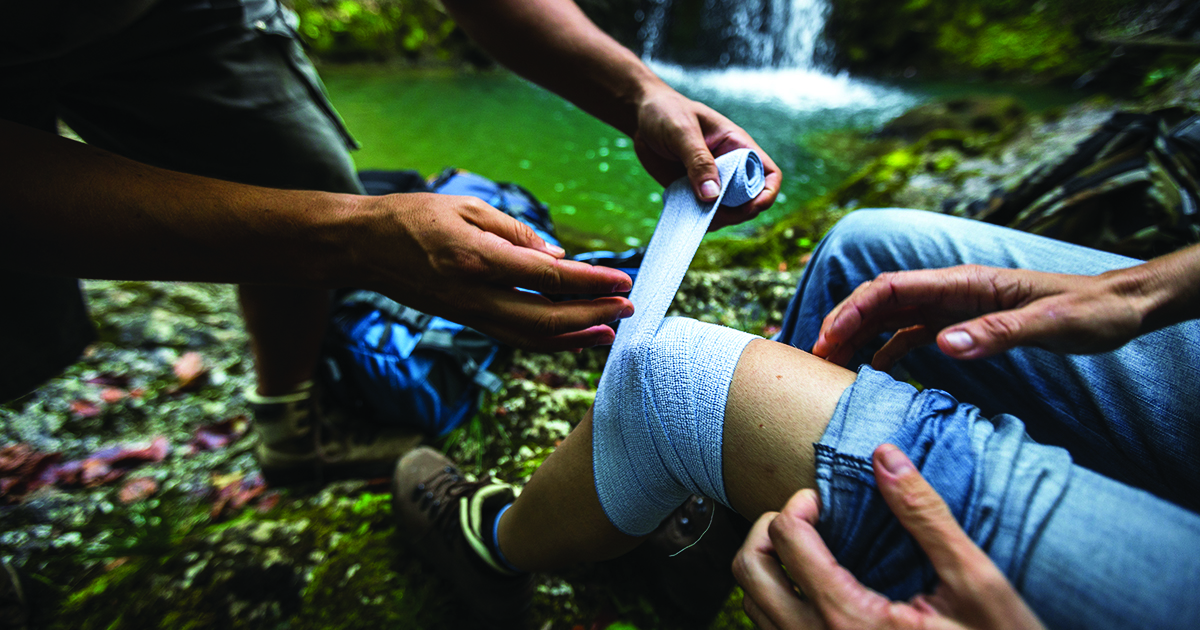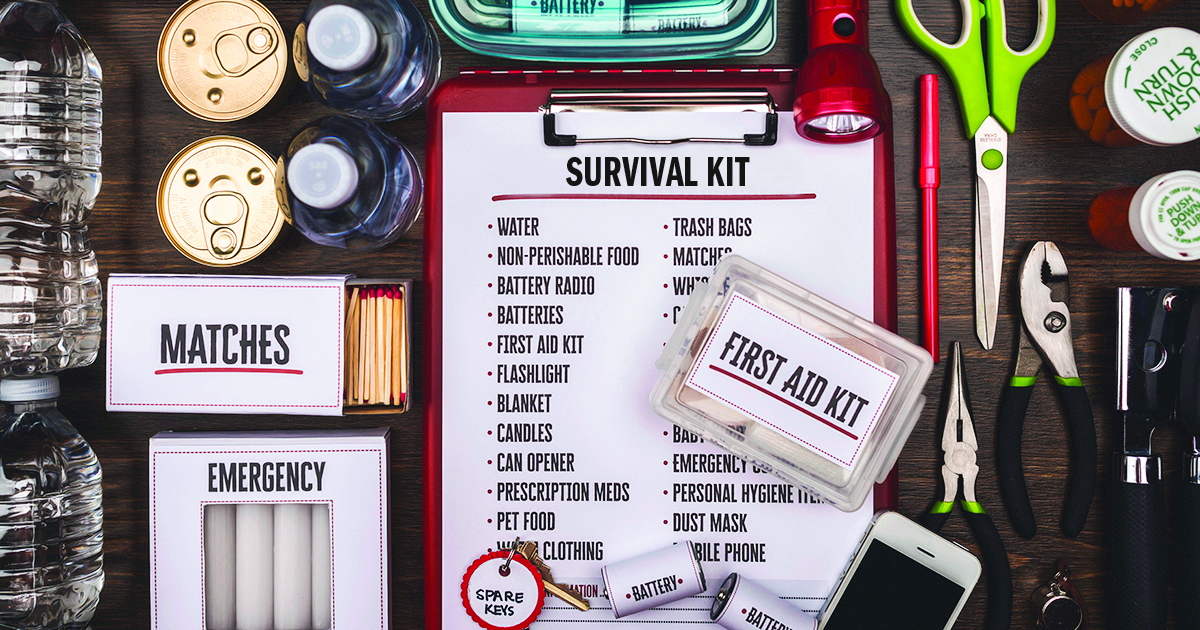How to Survive a Wilderness Emergency

Two friends, excited for an adventurous mountain bike ride, head out on a trailhead located an hour and a half from anywhere. On a steep rocky section, one friend goes over the handlebars in a dramatic, dusty crash. The other friend arrives quickly and finds her friend unconscious, gasping for air with an open fracture to her lower arm. The injured person regains consciousness quickly but the open fracture—and possible spine and brain injuries—are the serious problems.
In a wilderness emergency such as this one, there are several factors already working against the injured mountain biker and their surviving friend:
- They are more than an hour from medical care with no phone service,
- They told no one else where they were biking,
- They have a serious injury to deal with,
- They have no first aid supplies in their backpacks or in their truck, and
- It is getting dark.
So, what should they do? Read on to learn how to survive wilderness emergencies.
Are You Prepared?
The great outdoors is calling, and more and more people are heeding that call intending to have fun and adventure in remote places. Unfortunately, many on wilderness adventures are poorly prepared to deal with emergency situations such as the scenario outlined above, sudden illness or being lost. Whether you recreate, work, or live in the wilderness, sooner or later you will have to deal with an injury or illness.
But are you prepared? What first-aid supplies should you have in your truck before heading out on a weekend overland adventure? What should you have in a remote cabin to treat hypothermia? What first-aid supplies should be carried for tick bites on a long through-hike on the Appalachian Trail?
In the wilderness, one needs to be prepared to treat injuries and illnesses you normally would not treat when an ambulance is only minutes away. Proper knowledge and understanding of wilderness first aid can increase your odds of surviving even the most severe injuries and illnesses.
Precautions you take when heading out into the wilderness depends on several factors:
- How long you plan to be in the remote area
- How many people are going
- Weather you may encounter
- Activities you plan to do
- Pre-existing medical conditions (diabetes, allergies, etc.)
Wilderness First Aid: Emergency Care in Remote Locations, Sixth Edition is a great resource for the necessary emergency preparations for fun, adventure, living or working in remote locations.
This product contains the first-aid equipment and supplies you should have, information on improving your odds of survival and, prevention strategies for common (and less common) injuries and illnesses that may occur in the wilderness.
How to Survive in the Wilderness
First, prepare yourself and your adventure partners by taking a wilderness first-aid course taught by a qualified instructor. This will increase your skill, determination, and judgment during an emergency. In the event of an emergency, the time and money you spent on the course is a great investment and can save your life.
Next, outfit your vehicle with survival gear. Keep these items in your vehicle and remember to replenish them as needed.
When venturing away from your vehicle, you should carry a survival kit. The following items are essential to have when in remote locations. These items keep you alive and help you avoid getting lost or help find your way back. I advise you spend time becoming familiar with each item’s purpose and use. For example, having a map and compass does no good if you do not know how to route find or triangulate your location.

Water
Without water, you most likely will not survive more than three days. If possible, always disinfect water, here’s how: When near water sources such as rivers and lakes, use water filtration systems for disinfecting. This removes not only bacteria common to open water sources, but also removes larger particles and sediment. Using UV light will kill bacteria and viruses but does not filter out the “floaties," which is anything that you can see that should not be in water such as sediment, twigs, leaves, particles of any color.
Boiling water is an effective method for water disinfection. Before boiling, you can filter water through a shirt or clean sock first to remove larger particles. Make sure to bring the untreated water to a rolling boil and allow it to cool before drinking. Do not pour disinfected water into containers that just contained the dirty water.
Learn how to melt snow or ice using a stove, campfire, black plastic bags, emergency space blanket, sunlight, or candles.
Food
Humans can survive three weeks without food. However, to survive in the wilderness, you need energy and the psychological boost that only food provides.
Many adventurers make detailed plans regarding what they will eat for each meal and have all the cooking equipment for some spectacular meals. But, in remote locations, many fail to carry emergency food rations. These emergency food rations should be easy to prepare and not require any cooking. Energy bars, jerky, and hard candy are all compact, lightweight and can be stored for many months in a backpack or vehicle. Freeze dried food or MREs (Meals Ready to Eat) are other food rations to consider. Become knowledgeable about edible plants in your area, but don’t rely solely on this food source.
Shelter
Proper shelter from the elements is critical to surviving in remote locations. If possible, stay with your vehicle for shelter. It also makes it easier for rescuers to find you. Tents are preferred but not always available. Finding shelter in a natural cave or windbreak is preferred to making a shelter as it conserves vital energy needed to survive. Learn a variety of shelter building techniques such as digging a snow cave, using rope or wire with a tarp or even plastic bags. Carrying an emergency bivouac sack provides a lot of warmth for its size and weight.
Footwear and Clothing
The type of clothing and footwear you use depends on where you are going. At a minimum you should wear closed-toed shoes and bring a light jacket. But it’s important to be prepared for any situation with proper footwear and clothing for the conditions. Using layers for clothing is better than one bulky large coat, especially when you are hiking for survival. Remember, layers are to be removed to avoid sweating and added to provide warmth. Take the time to do this.
Heat
Become proficient at starting a fire under any conditions. However, in winter and desert conditions, finding wood may be difficult. A stove and fuel can be used for a heat source. Matches in a waterproof container are better than a lighter, especially in cold conditions. Candles provide light and heat as well. Carry fire starters such as toilet paper, char cloth, cotton balls soaked in petroleum jelly or dryer lint.
Light
Always bring a headlamp, flashlight (with fresh batteries), candle or glow stick for light, even when starting your hike in the morning.
Other necessary equipment
For route finding and navigation, know how to use a map and compass. Global positioning System (GPS) units are affordable and should be considered for every person traveling in remote locations. They can let others track your progress and let them know you are okay and GPS units can summon help just about anywhere in the world.
A tool and repair kit should consist of at least the following:
- Multifunction knife
- Duct tape
- Wire (baling, picture-hanging wire)
- Safety pins, needles, thread
- Nylon paracord (at least 50 feet)
- First aid supplies
Communication
Before leaving, always let someone back home know where you are going and when you should be home. In remote locations, communication with outside help should be considered a priority. When out on the trail, communication methods can be as simple as a whistle, flares or signal mirror, or as technologically advanced as mobile and satellite phones and GPS units that can summon help from anywhere. A common problem with this technology is the need for battery power. Always be prepared with backup batteries for these devices. Solar charging units should be considered.
Use code WFA25 to get 25% off with free ground shipping on Wilderness First Aid products from ECSI:
- Wilderness First Aid: Emergency Care in Remote Locations, Sixth Edition
- Wilderness First Aid Field Guide, Third Edition
Related Content:
- What The Resuscitation of Damar Hamlin Teaches us About CPR Training
- Back Blows, Abdominal Thrusts or Both: Proper First Aid for Choking Victims
About the Author: Steve Thygerson, Ph.D., MSPH, CIH is professor of environmental and occupational health at Brigham Young University in Provo, Utah. Prior to his appointment at BYU in 2008, he worked for nine years in various occupational and environmental health settings in the public and private sector. He is a Certified Industrial Hygienist and EMT. He is a past chair of the International Affairs Committee of the American Industrial Hygiene Association. As a member of Workplace Health Without Borders (WHWB), he mentors and consults with other occupational hygienists and provides occupational health training worldwide. Those countries include Nepal, Brazil, Peru, South Africa, Mozambique, Ethiopia, and Pakistan. For the past 20 years, he has authored first aid, CPR and wellness books including the Wilderness First Aid, Emergency Care in Remote Locations and Wilderness First Aid Field Guide. While not at work, he loves to run, mountain bike, backcountry ski, set out on family backpacking trips and is a wannabe overland expedition enthusiast.